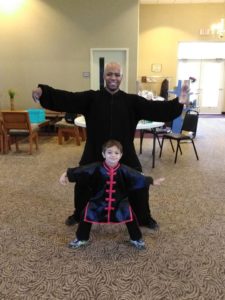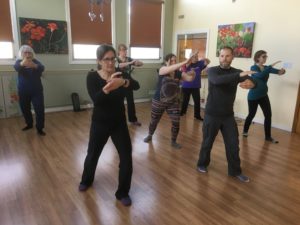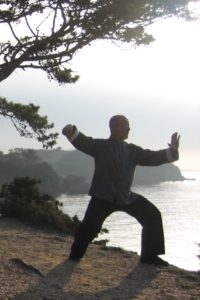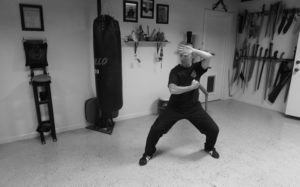Slanted FlyingJournal of Tai Chi Chuan
Training
Multiple Centers & Multiple Spheres in Taijiquan
We have circles/spheres with the center at our body’s center of mass (the lower dantien), others centered in the joints (the nine pearl bends), and more whose surfaces touch the points of contact with opponents. We also have circular movements (arcs, etc.) that are addressed in the following link on “random circles.” While the article does a good job, I will add additional information.
[see http://www.ycgf.org/Articles/RandomCircles_in_TJQ/RandomCircles_1.html]
 Any circle that is made (in any orientation) will have four quadrants, and the energy will be different in each. At the transitions (where the X and Y axes intersect the circle in the accompanying illustration), we need to change how we support the actions in the new quadrant. Too often, practitioners continue the energy from the prior quadrant when they transition into the new one. This weakens the alignment and support of the new action.
Any circle that is made (in any orientation) will have four quadrants, and the energy will be different in each. At the transitions (where the X and Y axes intersect the circle in the accompanying illustration), we need to change how we support the actions in the new quadrant. Too often, practitioners continue the energy from the prior quadrant when they transition into the new one. This weakens the alignment and support of the new action.
As an example, visualize making a horizontal circle in front of your body, similar to what is commonly done in introductory Yang style one hand push-hands (推手tuishou) drills. If we start with our right hand at the point farthest away from us and move counterclockwise, then we will arc to our left and towards us, then we continue towards us but arc to the right, followed by continuing right but arcing away from us, and then continuing away from us while arcing to the left.
When drawing the arc towards us, we need the wrist to be drawn by our elbow, which is drawn by our shoulder and continuing through our body all the way down to our feet and the ground. This is reversed when the arc is moving away from us. The relationship between our wrist, elbow, and shoulder also changes when changing from right to left or left to right. The four transition points are important to be aware of regardless of whether you, or your partner/opponent, initiate the movements.
Inherent in circular movement is the principle of going down before going up, left before right, etc. To take a partner/opponent through these opposite directions, where they may become vulnerable if not correctly changing their energy or structure appropriately at the transitions, one should start in one quadrant then move into two more (crossing two transition points).
If we use the simple counterclockwise circle described previously, one would start going left, but change to right at the first transition. Since this is but a single change, it may not be enough to be able to take advantage of. If one continues, then one also changes from going in to going out. If, instead of a horizontal circle, one changes their movement to a sphere, then one could also add a change from down to up (or up to down) in the same amount of movement. The more changes one’s opponent needs to respond to, the greater the chance that they will make errors that could potentially be exploited.
Of course, while the above example of the simple horizontal one hand push-hands drill uses a circle that remain in one orientation, complexities are involved when using spheres that allow multiple planes of movement, instead of circles; changing the size during the movement; moving the sphere’s/circle’s center while circling, etc. The aspects of a circle/sphere discussed above apply to whatever level of complexity one uses in their circling.
Although a simple circle or sphere is often used to explain qualities or principles that are desirable in Taijiquan, the human body is not a simple sphere, and it is capable of much more complex movements. The more that one can translate the qualities and principle to the infinite number of circles/spheres that we use, the better for one’s Taijiquan practice.
There are many benefits to moving with circularity including avoiding engaging the other’s force directly, being fluid and smooth, being changeable and adaptable, and making it difficult for the partner/opponent to follow correctly through all of the changes.
Zhang Yun stated in his article on “random circles” (see link above): “Random circles are dynamic, not static. Circles should be kept rolling and changing smoothly and naturally, never ending. An individual’s Taiji skill level can be judged by the random circles performance. The more circles are involved and the more changing can be done, the higher the skill level.”














One thought on “Multiple Centers & Multiple Spheres in Taijiquan”